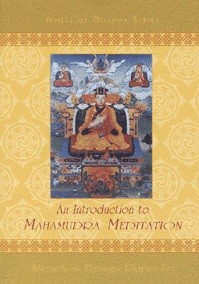
An Introduction to Mahamudra Meditation by The Venerable Khenchen Thrangu Rinpoche Geshe Lharampa is an essential guide. During the flourishing of the Mahamudra teachings in India in the 8th to 12th centuries, innumerable people practiced Mahamudra. Many of them attained realization through this practice. Mahamudra means “great seal” or “great symbol.” It is now used as the culmination of nearly all of the different sects of Tibetan Buddhist schools, where it is regarded as one of the most essential teachings.
Download the meditation guide here:
 An Introduction to Mahamudra Meditation
An Introduction to Mahamudra Meditation
What is Mahamudra meditation?
Mahamudra is a form of meditation that is central to certain schools of Tibetan Buddhism, particularly the Kagyu tradition but also practiced in others like the Gelug school. The term “Mahamudra” translates to “great seal” or “great symbol” in Sanskrit. It refers to a comprehensive system of meditation practices designed to help practitioners realize the ultimate nature of reality, leading to spiritual enlightenment.
The practice of Mahamudra is advanced and traditionally comes after preliminary practices (often referred to as “Ngöndro”). It encompasses a wide range of meditation techniques, including:
- Sutra and Tantra Mahamudra: The practice can be divided into Sutra Mahamudra, which is based more on mindfulness and awareness practices similar to those found in various forms of Buddhist meditation, and Tantra Mahamudra, which involves more esoteric practices, including deity yoga (visualizing oneself as a deity to embody divine qualities).
- Shamatha (calm-abiding meditation): This foundational technique involves focusing the mind on a single point of concentration to develop stability and calmness. Often, practitioners start with focusing on the breath, a neutral object, or a concept. The goal is to achieve mental tranquility and a stable state of concentration.
- Vipashyana (insight meditation): Building on the mental clarity and focus developed in shamatha, vipashyana involves analytical meditation to gain insight into the nature of reality and the mind. In the context of Mahamudra, this particularly involves insight into emptiness or the lack of inherent existence of all phenomena, and the realization of the non-dual nature of reality.
- Non-dual meditation: As practitioners progress, Mahamudra meditation involves transcending conceptual thought to experience the true nature of the mind and phenomena directly, beyond dualistic perceptions of self and other, subject and object.
- Daily life practice: Mahamudra is not just a formal meditation practice but a way of experiencing all aspects of life with a non-dual, present-moment awareness. It involves carrying the insights from meditation into everyday experiences.
- Guru Yoga: In Tibetan Buddhism, the relationship with a qualified teacher or guru is crucial. Guru Yoga practices in Mahamudra involve devotion to the guru and often include visualizations and mantras to receive the guru’s blessings and guidance, which are believed to be essential for progressing on the spiritual path.
Given the depth and complexity of these practices, direct study under a qualified teacher is considered crucial in Tibetan Buddhism. Practitioners are typically advised not to attempt advanced practices like Mahamudra without appropriate guidance, as doing so can lead to misunderstandings and potential obstacles in one’s practice and development.

Dear Mr.Houseman,
Can you please send me the ebook to my email id ‘naishadham.rk@gmail.com’
Regards
Murthy
I am interested to learn Mahamudra, please send the file.
dear Rinpoche la,
Please sent me the book. Thank you so much in advance. I have my personal email I.d. But I use very less so that’s why I gave you my business mail.
Thank you
Yours sincerely,
Karma tashi
Dear friends,
I am writing to offer you a free copy of an e-book I wrote about Tantric Buddhism for use in your online library. I just published it this year, and I am waiving all rights to the contents of the book and placing it in the public domain. “Great Bliss: Tantric Sex and the Path to Inner Awakening” is the first complete modern instruction book on Tantric Buddhism, and the first on Buddhist sexual yoga. The heart of the book is a first-ever translation from the Sanskrit of the Ninth Century master Shabara’s The Sadhana of Secret Vajravilasini, a masterpiece of the world’s spiritual-erotic literature, and an ideal text for sexual yoga practice. Great Bliss reveals thousand year-old secrets, and is a landmark contribution to the study and practice of Tantric sex in the West. The book includes hundreds of authentic practices, making it an almost inexhaustible resource for Tantra teachers and students.
I am a teacher of Tantric Buddhism in the tradition of the Indian siddhas. A student of many Tantric traditions for over thirty years, I trained as a lama under the guidance of the Tibetan master His Eminence Garchen Rinpoche, completing an intensive, solitary three-year retreat. I also trained with many Western Tantra teachers including Margot Anand. I received a Bachelor’s Degree with honors in Religion from Wesleyan University, where I studied Buddhism with Robert Thurman, and earned my master’s degree from Columbia University. For four years I served on the staff of Karma Triyana Dharmacakra monastery in Woodstock, New York, the North American headquarters of His Holiness the 17th Karmapa. This book is a result of my twenty year search to find the original teachings of Tantric Buddhism. My commitment is to return the profound practices of Buddhist sexual yoga to the modern world.
The book is 485 pp. in length. I can send it to you as a Word Doc file in read-only form. Please feel free to make this book a free
download on your website.
Sincerely,
John T. Houseman
Dear Mr.Houseman
I would be very greatful to You if You can send me a copy of Your Book ti my e-mail vajra2709@gmail.com
With regards,
Daniel